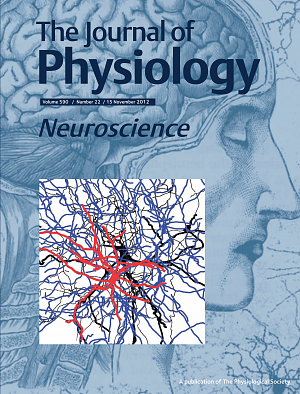 The cover image shows a light microscopic reconstruction of biocytin-labelled GABAergic neurogliaform cell and glutamatergic principal neuron of the mouse basolateral amygdala complex. Soma and dendrites (thick) of the neurogliaform cell are shown in red, and the axon (thin) is shown in blue; soma and dendrites (thick) and the axon (thin) of the principal cell are shown in black.
The cover image shows a light microscopic reconstruction of biocytin-labelled GABAergic neurogliaform cell and glutamatergic principal neuron of the mouse basolateral amygdala complex. Soma and dendrites (thick) of the neurogliaform cell are shown in red, and the axon (thin) is shown in blue; soma and dendrites (thick) and the axon (thin) of the principal cell are shown in black. Miroslawa Manko, Thomas Bienvenu, Yannis Dalezios and Marco Capogna report in the last issue of the Journal of Physiology (590.22:5611-5627, 2012) a novel interneuron type of the amygdala, termed neurogliaform cell, and study its function by a combination of in vivo and in vitro techniques. They used a mouse line expressing a green fluorescent protein (GFP) under the neuropeptide Y (NPY) promoter. Paired recordings between presynapticNPY-GFP-expressing (+) cells and postsynaptic principal neurons (PNs) of the basolateral amygdala (BLA) were performed. The NPY-GFP+ neurons displayed small somata and short dendrites embedded in a cloud of highly arborized axon, suggesting a neurogliaform cell (NGFC) type. A NPY-GFP+ cell evoked a GABA-A receptor-mediated slow inhibitory postsynaptic current (IPSC) in a PN and an autaptic IPSC. The slow kinetics of these IPSCs was likely caused by the low concentration and spillover of extracellular GABA. They also report that NGFCs of the BLA fired action potentials phase-locked to hippocampal theta oscillations in anaesthetized rats. When this firing was re-played in NPY+-NGFCs in vitro, it evoked a transient depression of the IPSCs. Presynaptic GABA-B receptors and functional depletion of synaptic vesicles determined this short-term plasticity. Synaptic contacts made by recorded NGFCs showed close appositions, and rarely identifiable classical synaptic structures. Thus, they report a novel interneuron type of the amygdala that generates volume transmission of GABA. The peculiar functional mode of NGFCs makes them unique amongst all GABAergic cell types of the amygdala identified so far.